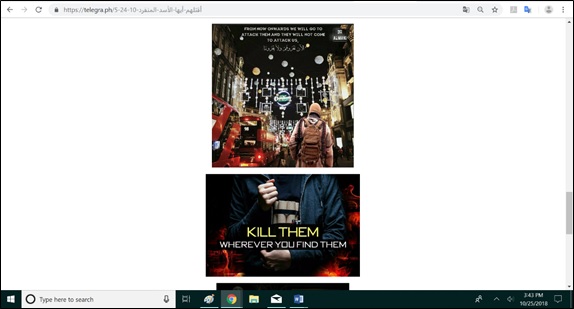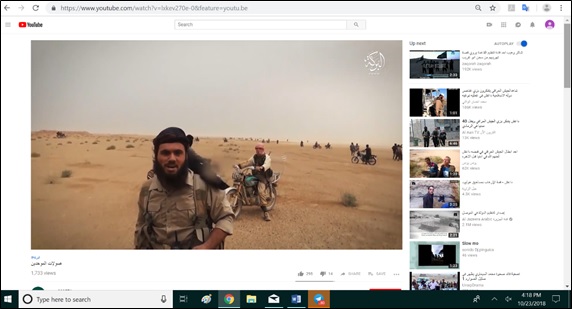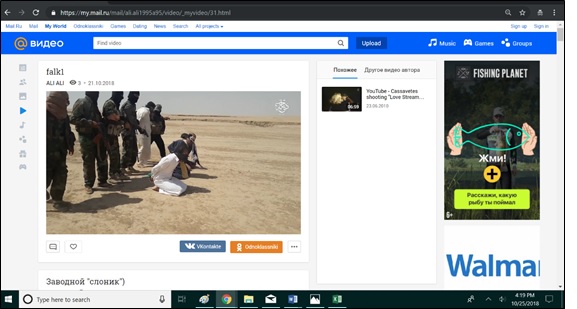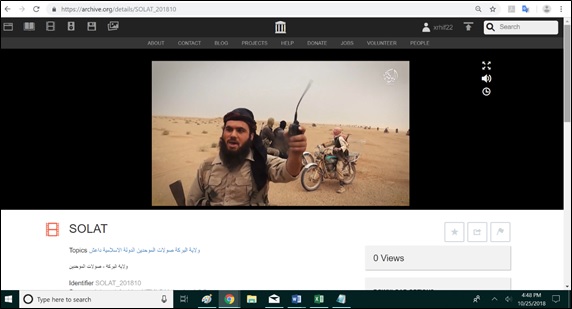As Anjem Choudary Content Is Removed Online, Other Extremists Remain
This month, convicted ISIS propagandist Anjem Choudary was freed from prison after serving only half of his original sentence. Choudary, the founding member of the extremist group al-Muhajiroun, which is now banned in the United Kingdom, was convicted in 2016 after pledging allegiance to ISIS and encouraging others to do the same. As the Counter Extremism Project (CEP) previously reported, Choudary has been linked to more than 600 extremists and through them, dozens of terror plots. Choudary’s release and connection to many other extremists highlights the need to prevent his teachings from being elevated on any Internet platform. To a certain extent, he has, as CEP has been unable to find Choudary’s worst offending content online.
While totally removing extremist content from the public consciousness may sound daunting, tech companies have previously succeeded at limiting the online reach of al Qaeda propagandist Anwar al-Awlaki. Awlaki shaped a generation of American terrorists, including the Fort Hood gunman, the Boston Marathon bombers and the perpetrators of massacres in San Bernardino, California and Orlando. The New York Times reported last November that of the more than 70,000 Awlaki related videos originally found on YouTube, only 18,600 of such remained – mostly news reports about his life, scholarly videos of his work or debates on the ethics of his death. YouTube began removing the videos, implementing a “near-total ban” in the face of growing calls for social media websites to play a more active role in content moderation. The removal of Awlaki content online undoubtedly helped end his posthumous power and presence.
But consistent content moderation enforcement from tech companies is hard to come by. Frequently spurred on only by a high-profile incident or widespread public criticism, online platforms are slow to prevent the promulgation of extremist videos. That’s a troubling metric for action, as CEP has identified at minimum 168 individuals who consumed official terrorist content and then went on to be arrested for terrorism related crimes, joined terrorist organizations, or carried out terrorist attacks. A significant amount of content is still accessible online, which needs to be removed from the public consciousness. One propagandist, Abdullah Faisal, is an ISIS propagandist and a U.S. Treasury Department Specially Designated Global Terrorist currently being held in Jamaica. Faisal is currently challenging his extradition to New York where he has been charged with aiding an undercover police officer posing as a potential ISIS recruit. Faisal’s work, along with that of Anwar Awlaki, has specifically been identified by the U.S. National Counterterrorism Center as promoting “violent extremist ideologies.” Despite the danger of Faisal’s rhetoric and support for terrorist organizations including ISIS, he is still given a wide platform by various video streaming and social media sites, as well as other web services companies. For example, a search for his name on YouTube yields over 2,000 results.
ISIS will continue to find mediums to spread its propaganda, manipulating all corners of the web and weaponizing social media to its advantage. According to military futurist Peter W. Singer, ISIS’s “mastery of social media” served as the first example of a terrorist group “turning social media power into real global power.” And while their mainstream social media presence may be dwindling, they are still active on lesser-known sites. For example, a pro-ISIS Telegram user posted a message on Telegra.ph inciting attacks and offering guidance on execution of different forms of attacks. The “telegra.ph” feature of Telegram serves as a public message board, and has been used extensively by ISIS and their online supporters.
ABDULLAH FAISAL
Content Report
Abdullah Faisal is an ISIS propagandist and a U.S. Treasury Department Specially Designated Global Terrorist currently being held in Jamaica. Faisal is currently challenging his extradition to New York where he has been charged with aiding an undercover police officer posing as a potential ISIS recruit. Faisal previously served four years in a British prison from 2003 to 2007 for soliciting murder, using threatening and insulting words, and using threatening and insulting recordings.
Faisal’s lectures have allegedly helped radicalize individuals involved in terror related offenses in the U.S., UK, and India. Faisal’s work, along with that of Anwar Awlaki, has specifically been identified by the U.S. National Counterterrorism Center as promoting “violent extremist ideologies.” Despite the danger of Faisal’s rhetoric and support for terrorist organizations including ISIS, he is still given a wide platform by various video streaming and social media sites, as well as other web services companies.
Survey of Abdullah Faisal Content
- URL: http://www.authentictauheed.com/
- Registrar: Go Montenegro Domains, LLC (https://www.gomontenegrodomains.com/)
- Registrant contact: Domains by Proxy, LLC (https://www.domainsbyproxy.com/)
- Domains by Proxy is owned by Go Daddy.
- Description: Authentic Tauheed is Abdullah Faisal’s website, which features several hundred of his lectures, as well as now obsolete information regarding Faisal’s PalTalk schedule. Faisal’s last lecture to be uploaded to the site was on August 16, 2017. Audio files are hosted by the Internet Archive, and embedded on the site.
YouTube
- A search for “Abdullah Faisal” on YouTube lead to 2,760 results. (October 29, 2018)
- A search for “AuthenticTauheed” on YouTube lead to 52 results. (October 29, 2018)
- A search for “Authentic Tauheed” on YouTube lead to 34 results. (October 29, 2018)
- The YouTube user AuthenticTauheed5 (756 subscribers) has uploaded 36 Abdullah Faisal lectures to the site.
- The YouTube user ATmovement2000 (99 subscribers) has uploaded over 40 Abdullah Faisal lectures to the site.
- Abdullah Faisal’s original Twitter account has been suspended.
- According to AuthenticTauheed.com’s “disclaimer” page, other Twitter accounts are not official, however it is dated June 20, 2011. Faisal may have created another account.
- The Twitter user @AuthenticTauhid (https://twitter.com/authentictauhid) has 1,001 followers, but the account is currently inactive. (October 29, 2018)
- The first tweet was May 18, 2013, the last tweet was October 29, 2016.
Internet Archive
- A search for “Abdullah Faisal” on the Internet Archive lead to 1,189 results. (October 29, 2018)
- This included 1,041 audio files, 107 texts, 39 movies, and two images.
- Over 100 audio files of Faisal’s lectures have over 1,000 views.
- A search for “Authentic Tauheed” on the Internet Archive led to 207 results. (October 29, 2018) (this number includes some overlap with the “Abdullah Faisal” search).
PalTalk
- Faisal rose to notoriety with his sermons and classes on the video chat program PalTalk.
- A PalTalk chat room (www.paltalk.com/g2/group/1347249) listed on the @AuthenticTauhid Twitter page is no longer active.
- An inactive PalTalk chat room still exists.“Authentic Tauheed,” 1,745 followers, the room owner is Shaikh Faisal_2000
- https://www.paltalk.com/g2/group/1347249153/DisplayGroupDetails.wmt
EXTREMIST CONTENT ONLINE
Use Of Message Board Function On Telegram By ISIS Supporters For Urging Attacks And Sharing Tactics
On Wednesday, October 24, a pro-ISIS Telegram user posted a message on Telegra.ph calling for attacks and offering advice on attack planning, knife tactics and truck attacks. Telegram’s “telegra.ph” feature, a basic message board that is viewable by anyone, is being used by ISIS’s online supporters to advocate for violence and share attack information. The Telegram communications platform has been used extensively by ISIS and their online supporters; however, channels and chats can be reported and removed. There appears to be no way to remove “telegra.ph” message board content.

Telegra.ph Post, Online As Of October 25, 2018
Decline In ISIS Content On YouTube, But Some Videos Still Remain
In an October 20 article in Wired, Rita Katz, the head of SITE Intelligence, the premier private monitor of online terrorist and extremist groups, stated that ISIS’ use of YouTube has declined significantly. Katz attributes this both to Google/YouTube’s efforts at content removal, and ISIS online supporters’ overall less use of the site. CEP agrees YouTube has definitely declined in importance for ISIS’s online propaganda efforts, but videos are still uploaded to the site. On Tuesday, October 23, ISIS online supporters uploaded “Assaults of the Monotheists,” released that day, which had over 1,700 views on YouTube when CEP analysts located it. While YouTube has increased their removal efforts, they still missed this critical upload, and potentially others.

“Assaults Of The Monotheists” On YouTube, With Over 1,700 Views, October 23, 2018
Online Pro-ISIS Group Advocates Killing The Pope
On October 24, the online pro-ISIS Abd al Faqir media group released an image on Telegram advocating killing the Pope. These types of threats are a low-cost mechanism of attempting to gain publicity for the group, spreading fear and attempting to persuade others to commit attacks. In addition to the Pope, Abd al Faqir has previously threatened Australia, the World Cup in Russia, the New York subway system, concerts and Manchester, England.

Abd al Faqir Image On Telegram Advocating Killing The Pope
Two New ISIS Videos Released On Numerous Platforms
ISIS released two new videos last week. The first, “Separation of the Heads,” was released from the group’s self-proclaimed Dijlah province in Iraq on Sunday, October 21. The video shows ISIS operations in Iraq, including raids by ISIS fighters disguised as Iraqi security forces, assassinations of village leaders, an attack on a soccer field and beheadings. The video was originally released on at least 20 websites in addition to Telegram: pc.cd, the Microsoft One Drive, the Internet Archive, top4top, mail.ru, Dailymotion, Google Drive, Google Photos, file.fm, Gulfupload, mega.nz, nofile.io, ok.ru, tune.pk, upmlf.com, vidbom.com, Vimeo, Dropbox, Vidio and Yadi.sk. Four days later, the video was still available on four websites in addition to Telegram: mail.ru, gulfupload, nofile.io and upmlf.com.

“Separation Of The Heads” On Mail.ru On October 25, Four Days After It Was Uploaded
The second video, “Assaults of the Monotheists,” from ISIS’s self-proclaimed al-Barakah province in Syria was released on October 23. The video shows combat between ISIS and Kurdish forces, and includes the taking of prisoners, the dragging of bodies and dozens of corpses. In addition to Telegram, the video was released on at least 20 websites: YouTube, Mediafire, mega.nz, the Internet Archive, the Microsoft One Drive, top4top, mail.ru, Dailymotion, Google Drive, Google Photos, file.fm, pc.cd, nofile.io, ok.ru, tune.pk, vidbom, Amazon Cloud Drive, Dropbox, Vidio and Yadi.sk. Two days after the video was uploaded, it was still available on six websites in addition to Telegram: the Internet Archive, Dropbox, Mediafire, top4top, nofile.io and yadi.sk.

“Assault Of The Monotheists” On The Internet Archive, October 25, 2018
BACKGROUND
CEP Senior Adviser Ian Acheson: Anjem Choudary Must “Disappear From Public Consciousness.” “What is certain is that we will need to be imaginative and take risks to counter a pernicious death cult ideology which has claimed tens of thousands of lives worldwide and directly threatens us. We need people like Choudary to disappear from public consciousness. Separation in custody can protect the public, deny access to potential new recruits and provide the space for them to disengage from their hateful beliefs. But beyond the prison gates, in the full glare of publicity with someone who craves infamy with the infidels, it is another matter entirely. Releasing one of IS’s most successful recruiters back into society to finish his sentence will surely give Choudary back the power he has not really had in prison.” (Ian Acheson, “It’s Important That We Starve Bogeyman Anjem Choudary Of The Power He Craves,” The Sun, 10/18/18)
YouTube Removed Leading English-Language Jihadist Recruiter Anwar al-Awlaki Only After Public Criticism. “For eight years, the jihadist propaganda of Anwar al-Awlaki has helped shape a generation of American terrorists, including the Fort Hood gunman, the Boston Marathon bombers and the perpetrators of massacres in San Bernardino, Calif., and Orlando, Fla. And YouTube, the world’s most popular video site, has allowed hundreds of hours of Mr. Awlaki’s talks to be within easy reach of anyone with a phone or computer. Now, under growing pressure from governments and counterterrorism advocates, YouTube has drastically reduced its video archive of Mr. Awlaki, an American cleric who remains the leading English-language jihadist recruiter on the internet six years after he was killed by a United States drone strike. Using video fingerprinting technology, YouTube now flags his videos automatically and human reviewers block most of them before anyone sees them, company officials say. A search for ‘Anwar al-Awlaki’ on YouTube this fall found more than 70,000 videos, including his life’s work, from his early years as a mainstream American imam to his later years with Al Qaeda in Yemen.” (Scott Shane, “In ‘Watershed Moment,’ YouTube Blocks Extremist Cleric’s Message,” The New York Times, 11/12/17)
ISIS’ Mastery Of Social Media Weaponization Has “Created A Dangerous Model” Likely To Be Copied By Future Terrorist Groups. “Dunford said the group’s ability to produce videos, web posts and other outreach has been cut by more than 80 percent over the last two years, and that the group’s once-flagship monthly propaganda magazine hasn’t been published in more than a year. ‘Among the many things we need to think about as we look at violent extremism into the future, their ability to leverage technology, cyber capabilities, information operations … is one of the things we need to anticipate and be out in front of,’ Dunford said. ISIS’ mastery of social media in its initial swath of victories in 2014 has created a dangerous model that is likely to be mimicked by future groups, said Singer, who wrote about the prominent role online campaigns will have in future conflicts in his new book, ‘Like War: The Weaponization of Social Media.’ ‘I don’t know exactly what ‘ISIS 2.0’ is, but I know we will learn about them on social media,’ he said. The group was the first example of a terror network turning social media power into real global power, he said.” (Tara Copp, “DoD Knows Future Terror Groups Will Seek To Copy ISIS, Turn Social Media Into A Weapon,” Military Times, 10/16/18)